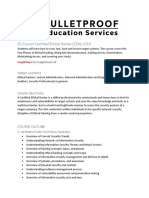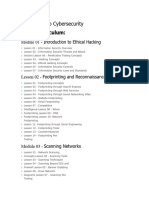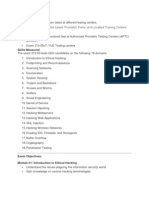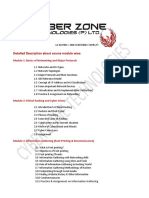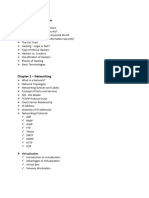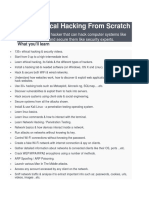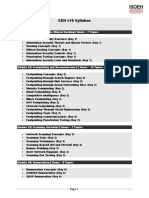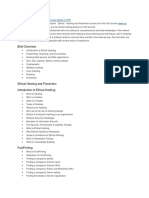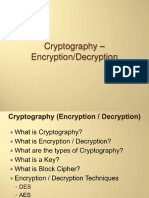0% found this document useful (0 votes)
12 views9 pagesNull-Ethical Hacking Course Module
The document outlines a comprehensive Ethical Hacking Course consisting of 20 modules covering topics such as information security fundamentals, networking, Kali Linux, reconnaissance, scanning, enumeration, vulnerability analysis, system hacking, malware threats, sniffing, social engineering, denial-of-service attacks, penetration testing, web and mobile hacking. Each module includes key concepts, techniques, and tools essential for ethical hacking and cybersecurity. The course aims to equip learners with practical skills and knowledge to identify and mitigate security vulnerabilities.
Uploaded by
abhinavbindranmmsCopyright
© © All Rights Reserved
We take content rights seriously. If you suspect this is your content, claim it here.
Available Formats
Download as PDF, TXT or read online on Scribd
0% found this document useful (0 votes)
12 views9 pagesNull-Ethical Hacking Course Module
The document outlines a comprehensive Ethical Hacking Course consisting of 20 modules covering topics such as information security fundamentals, networking, Kali Linux, reconnaissance, scanning, enumeration, vulnerability analysis, system hacking, malware threats, sniffing, social engineering, denial-of-service attacks, penetration testing, web and mobile hacking. Each module includes key concepts, techniques, and tools essential for ethical hacking and cybersecurity. The course aims to equip learners with practical skills and knowledge to identify and mitigate security vulnerabilities.
Uploaded by
abhinavbindranmmsCopyright
© © All Rights Reserved
We take content rights seriously. If you suspect this is your content, claim it here.
Available Formats
Download as PDF, TXT or read online on Scribd
/ 9
















